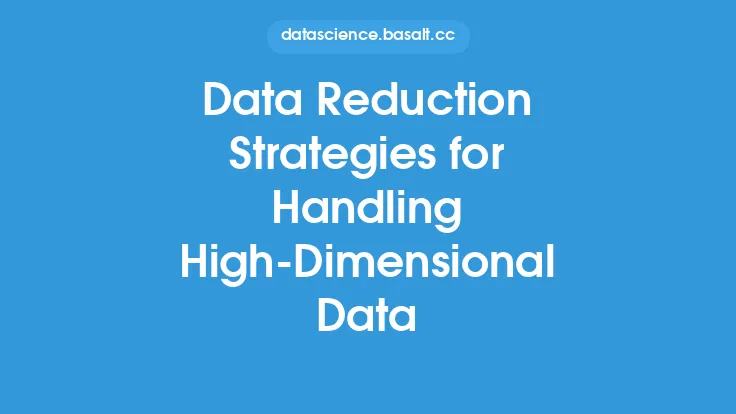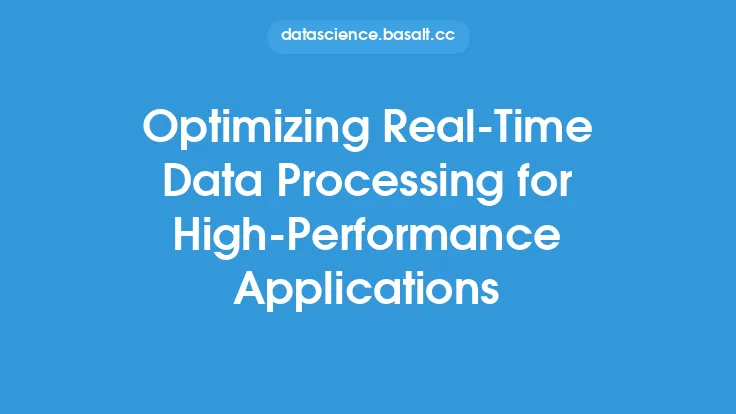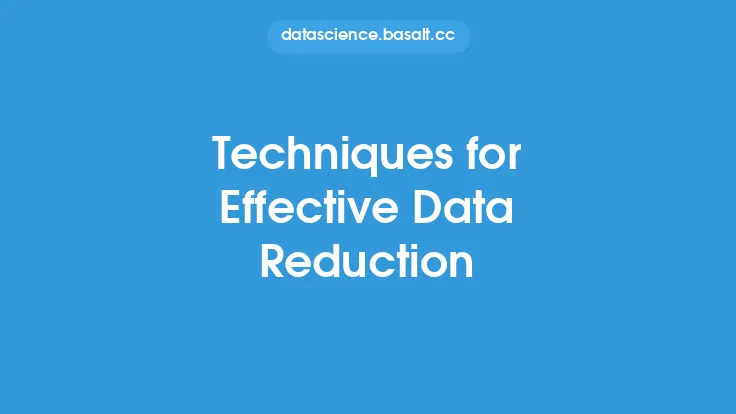Handling high-dimensional data is a common challenge in data analysis, as it can lead to the curse of dimensionality, where the number of features or dimensions in the data far exceeds the number of samples. This can result in decreased model performance, increased computational complexity, and reduced interpretability. To mitigate these issues, data reduction strategies are employed to reduce the number of features or dimensions in the data while preserving the most important information. In this article, we will explore the various data reduction strategies for handling high-dimensional data.
Introduction to High-Dimensional Data
High-dimensional data refers to datasets with a large number of features or dimensions, often exceeding the number of samples. This type of data is common in fields such as genomics, image processing, and text analysis, where the number of features can be in the thousands or even millions. High-dimensional data poses several challenges, including the risk of overfitting, increased computational complexity, and reduced model interpretability. To address these challenges, data reduction strategies are used to reduce the number of features or dimensions in the data while preserving the most important information.
Types of Data Reduction Strategies
There are several types of data reduction strategies, including feature selection, feature extraction, and dimensionality reduction. Feature selection involves selecting a subset of the most relevant features from the original dataset, while feature extraction involves transforming the original features into a new set of features that are more informative. Dimensionality reduction, on the other hand, involves reducing the number of dimensions in the data by transforming the original features into a lower-dimensional space. Each of these strategies has its own strengths and weaknesses, and the choice of strategy depends on the specific problem and dataset.
Feature Selection Methods
Feature selection methods involve selecting a subset of the most relevant features from the original dataset. There are several feature selection methods, including filter methods, wrapper methods, and embedded methods. Filter methods evaluate the relevance of each feature independently, using metrics such as correlation or mutual information. Wrapper methods, on the other hand, evaluate the performance of a model using different subsets of features and select the subset that results in the best performance. Embedded methods integrate feature selection into the model training process, using techniques such as regularization to select the most relevant features. Some common feature selection methods include recursive feature elimination, LASSO regression, and random forest feature importance.
Feature Extraction Methods
Feature extraction methods involve transforming the original features into a new set of features that are more informative. There are several feature extraction methods, including principal component analysis (PCA), independent component analysis (ICA), and linear discriminant analysis (LDA). PCA involves transforming the original features into a new set of features that capture the most variance in the data, while ICA involves transforming the original features into a new set of features that are independent and non-Gaussian. LDA, on the other hand, involves transforming the original features into a new set of features that maximize the separation between classes. Other feature extraction methods include t-SNE, autoencoders, and sparse coding.
Dimensionality Reduction Methods
Dimensionality reduction methods involve reducing the number of dimensions in the data by transforming the original features into a lower-dimensional space. There are several dimensionality reduction methods, including PCA, t-SNE, and autoencoders. PCA involves transforming the original features into a new set of features that capture the most variance in the data, while t-SNE involves transforming the original features into a new set of features that preserve the local structure of the data. Autoencoders, on the other hand, involve transforming the original features into a new set of features that capture the most important information in the data. Other dimensionality reduction methods include LLE, ISOMAP, and diffusion maps.
Evaluating Data Reduction Strategies
Evaluating data reduction strategies is crucial to ensure that the most important information in the data is preserved. There are several metrics that can be used to evaluate data reduction strategies, including accuracy, precision, recall, and F1 score. These metrics can be used to evaluate the performance of a model using the reduced data, and to compare the performance of different data reduction strategies. Other metrics that can be used to evaluate data reduction strategies include dimensionality reduction metrics, such as the reconstruction error, and feature selection metrics, such as the number of selected features.
Real-World Applications of Data Reduction Strategies
Data reduction strategies have numerous real-world applications, including image processing, text analysis, and genomics. In image processing, data reduction strategies can be used to reduce the number of pixels in an image while preserving the most important information. In text analysis, data reduction strategies can be used to reduce the number of features in a text dataset while preserving the most important information. In genomics, data reduction strategies can be used to reduce the number of genes in a genomic dataset while preserving the most important information. Other real-world applications of data reduction strategies include recommender systems, natural language processing, and time series analysis.
Challenges and Limitations of Data Reduction Strategies
While data reduction strategies can be effective in reducing the number of features or dimensions in a dataset, they also have several challenges and limitations. One of the main challenges of data reduction strategies is the risk of losing important information in the data. This can occur if the data reduction strategy is not carefully chosen, or if the reduced data is not representative of the original data. Another challenge of data reduction strategies is the computational complexity of the reduction process, which can be time-consuming and require significant computational resources. Other challenges and limitations of data reduction strategies include the need for careful evaluation and validation, the risk of overfitting, and the need for domain expertise.
Future Directions of Data Reduction Strategies
The field of data reduction strategies is rapidly evolving, with new methods and techniques being developed to address the challenges of high-dimensional data. Some of the future directions of data reduction strategies include the development of more efficient and effective algorithms, the integration of data reduction strategies with other machine learning techniques, and the application of data reduction strategies to new domains and problems. Other future directions of data reduction strategies include the development of more robust and scalable methods, the use of data reduction strategies for real-time data processing, and the integration of data reduction strategies with other data analysis techniques, such as data visualization and data mining.





